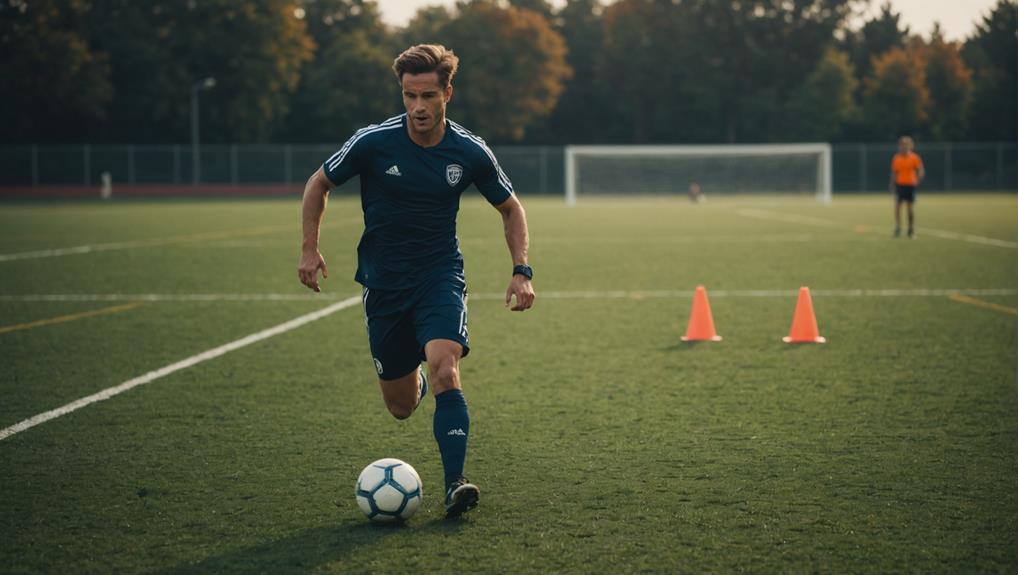
Creating an Effective Soccer Conditioning Program
August 15, 2024Craft an exceptional soccer conditioning program by combining speed training, agility drills, and cutting-edge technology like Blazepod. Enhance your on-field performance with drills that boost acceleration, agility, and efficiency while improving stamina and decision-making skills. Utilize Blazepod for real-time feedback on balance, coordination, and agility just like EURO 2024 players. Goalkeeper training is vital for strategic saves, while defensive strategies sharpen your positioning and interception abilities. Incorporate fartlek running and incremental intensity progression for improved fitness gains. Don't forget to focus on speed techniques, stretching, and agility drills to elevate your game to the next level.
Soccer Conditioning Drills Overview
To effectively boost your performance on the soccer field, understanding the Soccer Conditioning Drills Overview is necessary. Speed training plays an essential role in enhancing your abilities on the field. By incorporating speed training drills into your conditioning program, you can improve your acceleration, agility, and overall quickness during gameplay.
Sprinting drills, in particular, are crucial for building stamina, increasing speed, and maximizing your oxygen utilization on the field.
Engaging in speed training not only enhances your physical capabilities but also sharpens your mental focus during high-intensity moments in a match. The combination of sprinting exercises and agility drills can help you react swiftly to changing game situations, giving you a competitive edge over opponents.
Specific Conditioning Drills
Enhance your soccer conditioning with a range of specific drills designed to boost your performance on the field.
Pain Shuttles are a popular choice, involving high-intensity intervals with short rest periods to push your limits and improve your cardiovascular endurance.
On-Ball Off-Ball Running Drills for Soccer are excellent for simulating game scenarios, enhancing your conditioning, and sharpening decision-making skills under pressure.
To develop explosive power and leg strength, incorporate Step Jumps into your training regimen. These drills help you explode off the ground, essential for sprinting and jumping in soccer.
Torture Run Team Soccer Drills are perfect for challenging your endurance and mental toughness, incorporating various running patterns to keep you on your toes.
For defensive skills, agility, and communication, try 3-on-3 Force Marking Soccer Team Conditioning Drills. These drills focus on improving your defensive capabilities while enhancing your teamwork on the field.
Incorporating these soccer conditioning drills into your training routine will elevate your game to the next level.
Blazepod Technology Insights
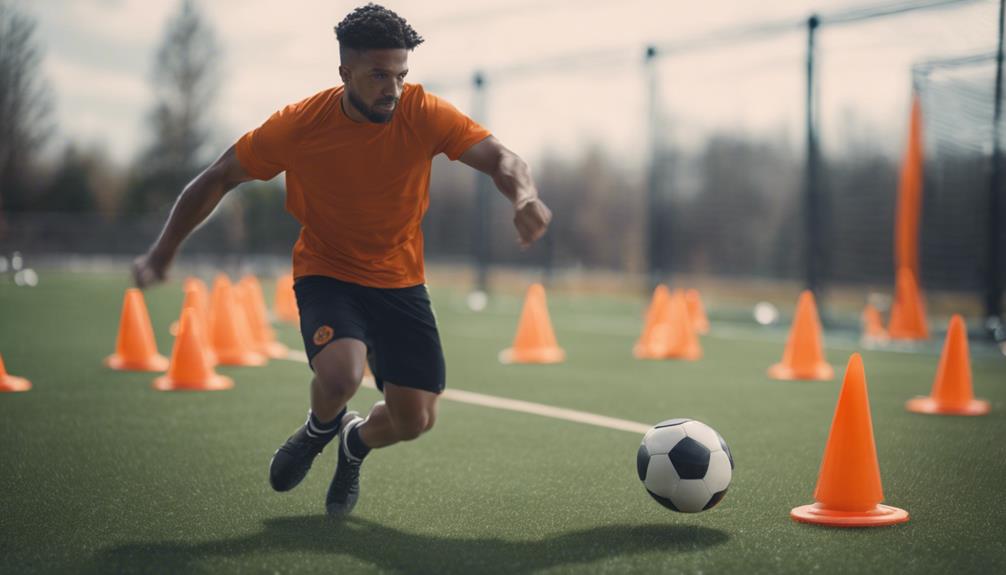
Blazepod Technology Insights offer a cutting-edge approach to tracking and enhancing soccer conditioning through Bluetooth-enabled pods. These pods, known for their durability with smash-proof and waterproof features, are equipped with suction cups and straps for versatile setup during soccer training sessions.
Noticeably, EURO 2024 players have embraced BlazePods Reactive Intelligence Technology to elevate their soccer conditioning.
Blazepod technology complements soccer conditioning drills by delivering real-time feedback on vital aspects like agility, speed, and reaction time. This instant data allows coaches and players to monitor progress in stability, balance, coordination, and overall fitness levels effectively.
Goalkeeper Training Essentials
You're about to learn the key essentials for goalkeeper training. Understanding the critical role goalkeepers play in defense, the dedication required for skill development, and the importance of team support are fundamental aspects to ponder.
Let's delve into how you can enhance your goalkeeper abilities and make a significant impact on your team's success.
Goalkeeper Role Importance
Mastering the goalkeeper role in soccer requires dedication, skill, and continuous improvement due to its specialized nature. Goalkeepers aren't just players; they're the last line of defense, responsible for preventing goals and organizing the team's defensive strategy.
The importance of goalkeepers can't be overstated, as they play a pivotal role in communicating with teammates, making critical saves, and directing the defense during matches.
Due to the limited professional spots available for goalkeepers, training and practice are essential for success in this position. Goalkeepers must undergo specific drills and techniques to enhance their reflexes, positioning, and shot-stopping abilities.
Their unique role on the field requires them to be agile, quick-thinking, and mentally sharp at all times.
Training Dedication Requirements
To excel in the goalkeeper position, dedication to training is an essential requirement. Goalkeeper training demands consistent effort, skill development, and a commitment to continuous improvement. The limited availability of professional goalkeeper spots underscores the necessity for goalkeepers to devote themselves to rigorous and regular training sessions. Goalkeepers are pivotal in a team's defense, emphasizing the critical role that their training plays in the overall success of the team.
Training is the cornerstone of accessing a goalkeeper's full potential and ensuring peak performance during matches. By focusing on refining techniques, mastering positioning, and honing decision-making skills, goalkeepers can elevate their game and make impactful contributions to their team's performance.
As a result, a goalkeeper's dedication to training isn't just about personal growth but also about enhancing the team's defensive capabilities and overall success on the field.
Defensive Team Support
Goalkeeper training essentials focus on honing essential defensive skills like diving, catching, and positioning to enhance overall team performance. In addition to mastering these fundamental skills, strength training is an essential component of a goalkeeper's training regimen.
Building strength in key muscle groups such as the core, legs, and upper body is vital for goalkeepers to execute explosive dives, command their penalty area effectively, and withstand the physical demands of the position. Strength training not only improves a goalkeeper's physical capabilities but also helps prevent injuries by enhancing muscle stability and endurance.
Defensive Soccer Strategies Breakdown
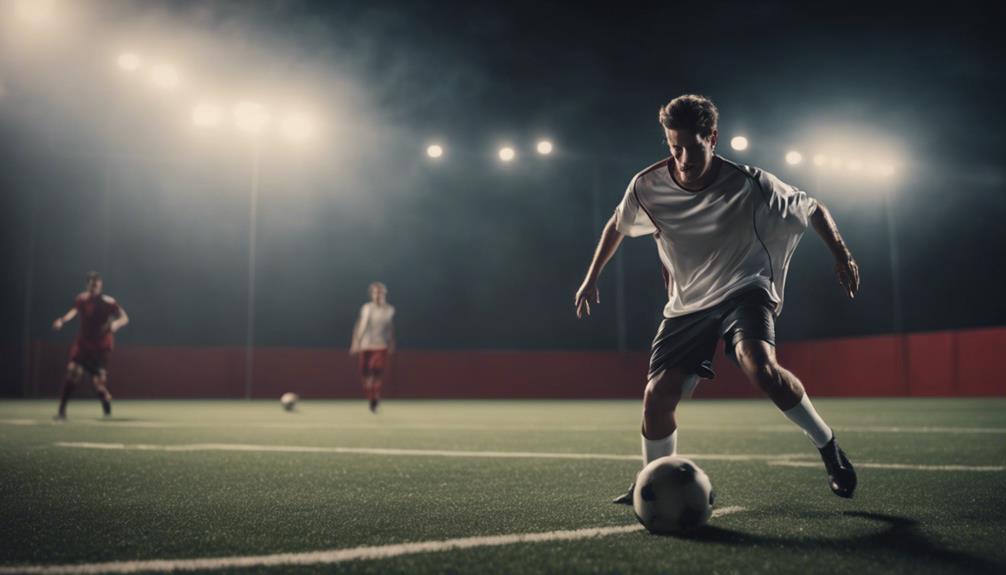
Enhancing defensive soccer strategies involves honing players' skills in positioning, marking, and intercepting passes to fortify the team's defensive capabilities.
Defensive drills are essential for training players to anticipate opponents' movements and function as a cohesive defensive unit.
Mental attentiveness and physical agility are vital for executing effective defensive strategies that can thwart the opposition's attacks.
By engaging in these drills, players enhance their abilities to react quickly and make tactical decisions during matches.
Strong defensive strategies play a pivotal role in a team's success in competitive soccer games by preventing goals and securing victories.
Investing time and effort in defensive training not only strengthens the team's defensive line but also boosts the overall performance on the field.
Developing a solid defensive foundation is key to achieving success and maintaining a competitive edge in soccer matches.
Fartlek Running Benefits
You'll love the benefits of fartlek running in your soccer conditioning program.
By mixing up your running speeds, you'll improve your endurance, speed, and agility, all essential for a stellar soccer performance.
Plus, gradually bumping up the intensity will help you ace those soccer-specific movements on the field.
Varied Running Intensities
Fartlek running, with its random variations of running speeds, offers numerous benefits for soccer players looking to improve their conditioning. This type of training is excellent for simulating the intermittent nature of a soccer match, where players need to switch between walking, jogging, and sprinting.
By incorporating fartlek sessions lasting 20-30 minutes, athletes can challenge themselves to maintain a level 7 of fatigue, enhancing their endurance gradually. The key is to vary the intensity throughout the workout to mimic the demands of a game effectively.
Soccer-Specific Movement Focus
To improve your soccer-specific movements and overall performance, incorporating Fartlek running into your conditioning program is highly beneficial. Fartlek training, with its random mix of running speeds, helps simulate the agility, speed, and endurance required in soccer.
By engaging in Fartlek sessions lasting 20-30 minutes at a moderate fatigue level, around a 7 on the intensity scale, you can enhance your soccer performance significantly. This type of training allows you to mimic game scenarios by focusing on specific movements like sprinting, jogging, and walking, leading to improved on-field capabilities.
Additionally, gradually increasing the intensity of your Fartlek running over time won't only boost your overall fitness but also elevate your soccer performance to new levels. Incorporating Fartlek running into your routine can be a game-changer, helping you excel in the dynamic and fast-paced environment of soccer.
Incremental Intensity Progression
Consider gradually increasing the intensity of your Fartlek running sessions over a span of weeks to maximize your soccer-specific fitness gains. Fartlek running benefits players by improving their speed, endurance, and overall performance on the field. By incorporating random intervals of running, jogging, and sprinting, you can target different energy systems and enhance your soccer-specific fitness levels effectively. Aim to reach a level 7 of fatigue during 20-30 minute Fartlek sessions to challenge your body and push your limits.
Incremental intensity progression in Fartlek running allows soccer players to enhance their sprinting, jogging, and walking abilities gradually. This method not only improves your cardiovascular fitness but also helps in developing speed and agility essential for soccer.
Speed Running Techniques
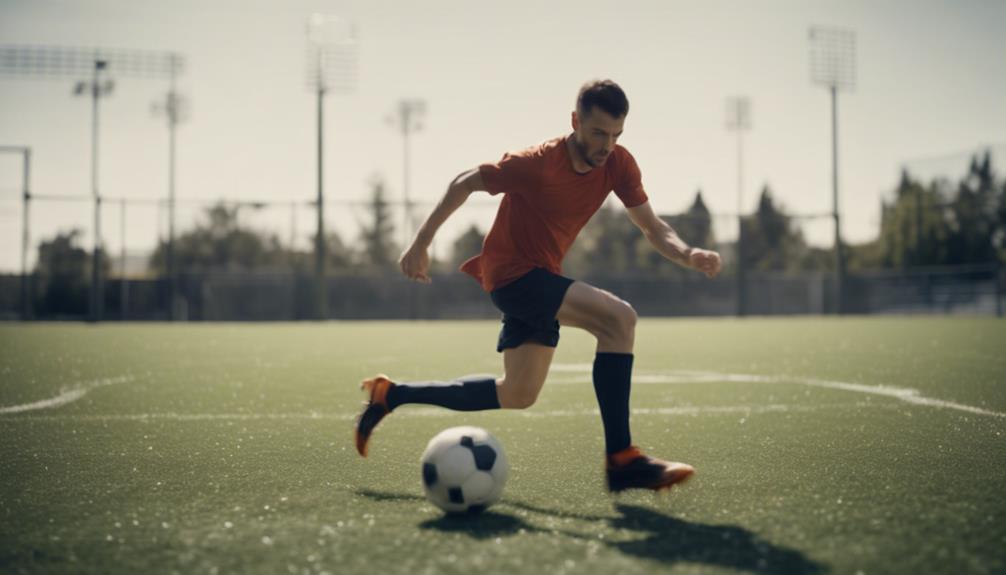
Enhance your speed and running form with structured speed running techniques that incorporate jogging, sprinting, cruising, and walking in a controlled cycle. During speed running sessions, focus on achieving your top speed during sprints of around 20 yards, while maintaining a cruising speed at 75% intensity. Pay close attention to your running form, ensuring proper posture and coordinated arm movements to optimize performance and efficiency.
Remember to allow for adequate recovery between sprints to give your best effort and prevent fatigue.
By incorporating speed running into your training regimen, you can develop essential skills for soccer such as acceleration, rapid change of direction, and overall speed on the field. These techniques not only improve your physical abilities but also enhance your on-field performance, making you a more effective and dynamic player.
Speed running is a vital component of a well-rounded conditioning program for soccer players seeking to elevate their game.
Stretching Sessions Importance
You need to understand the significance of stretching sessions in your soccer conditioning program.
Flexibility is vital for soccer performance, and stretching can help you achieve that.
Not only does stretching enhance flexibility, but it also reduces the risk of injuries during your training and matches.
Flexibility for Soccer
Flexibility plays an essential role in soccer, contributing to injury prevention and performance enhancement on the field.
When focusing on flexibility for soccer, keep these key points in mind:
- Targeted Stretching: Concentrate on key muscle groups like hamstrings, quads, and calves during stretching sessions to improve range of motion and agility.
- Routine Duration: Best stretching routines involve holding each stretch for 20-30 seconds to maintain muscle elasticity and readiness for practice.
- Game Day Preparation: Incorporating stretching on match days can prime the nervous system and prepare players for the physical demands of the game.
Stretching Benefits
When it comes to enhancing your soccer performance, focusing on the importance of stretching sessions can have a significant impact on your overall physical readiness and recovery.
Integrating proper warm-up and cool-down stretching routines into your training regimen is essential. Stretching at the end of your session helps enhance flexibility, decrease muscle tension, and improve recovery. By holding stretches for 20-30 seconds per muscle group, you can increase your range of motion and prevent injuries effectively. Targeting muscle groups like hamstrings, groins, quads, calves, and lower back during stretching sessions aids in overall muscle maintenance and boosts muscle elasticity.
These stretching exercises not only prepare your body for practice but also enhance your on-field performance notably. Additionally, including stretching into your routine on match days can stimulate your nervous system, prime your body for action, and optimize your overall performance during the game.
Injury Prevention Stretches
Incorporating injury prevention stretches into your post-workout routine is necessary for maintaining muscle flexibility and reducing the risk of injuries in soccer players. To maximize the benefits of these stretches, consider the following:
- Enhanced Flexibility: Stretching sessions at the end of workouts help improve flexibility, allowing your muscles to move through their full range of motion. This increased flexibility can contribute to better performance on the field and decreased chances of injury.
- Improved Muscle Elasticity: Holding each stretch for 20-30 seconds can greatly enhance muscle elasticity. This elasticity is important for preventing muscle strains and tears during soccer activities.
- Muscle Maintenance: Performing 2 stretches per muscle group post-workout aids in muscle maintenance. Proper stretching routines targeting hamstrings, groins, quads, calves, and lower back areas can help keep your muscles in top condition, reducing the likelihood of injuries.
Incorporating these injury prevention stretches into your routine is essential for your overall recovery and long-term well-being as a soccer player.
Soccer Agility Drills Overview
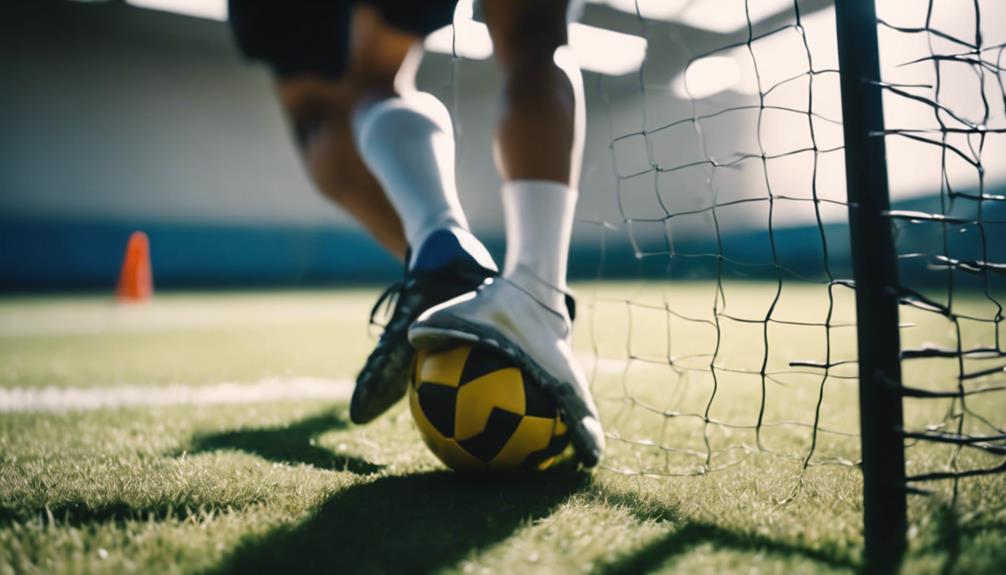
Improving your soccer agility is vital for enhancing your performance on the field. Agility drills are designed to focus on enhancing footwork, speed, and change of direction, ultimately improving your maneuverability during games.
These drills not only work on your physical attributes but also help improve your reaction time, coordination, and overall agility, which are pivotal for success in soccer matches.
Incorporating agility ladder drills, cone drills, and shuttle runs into your training regimen can greatly boost your agility and performance levels.
By engaging in these agility drills, you'll be better equipped to navigate quickly and effectively through the fast-paced and dynamic game situations that soccer presents.
Ultimately, by honing your agility through targeted drills, you'll increase your on-field effectiveness and be able to contribute more to your team's success.
Soccer Conditioning Drills Benefits
Enhance your soccer performance and fitness levels through dedicated soccer conditioning drills. These drills are designed to push your limits and elevate your game to new heights.
Here are the benefits of incorporating effective soccer conditioning drills into your training regimen:
1. Improved Endurance and Speed:
Soccer conditioning drills target your cardiovascular system, increasing your stamina for those intense moments on the field. Enhanced speed and agility help you outmaneuver opponents and make quick plays.
2. Enhanced Ball Control and Coordination:
By including both ball and non-ball exercises in your conditioning program, you refine your ball-handling skills, boost coordination, and improve overall performance during matches.
3. Progress Tracking and Goal Setting:
Utilizing technologies like Blazepod allows you to monitor your progress in real-time, enabling you to set specific goals for improvement and track your development over time. Stay motivated and focused on reaching your full potential with structured soccer conditioning drills.
Conclusion
So, there you have it – your ultimate guide to creating an effective soccer conditioning program! With these powerhouse drills and training tips, you'll be dominating the field in no time.
Get ready to take your game to the next level, push your limits, and leave your opponents in the dust. Train hard, play smart, and watch as your skills skyrocket to superstar status.
Let's do this!


